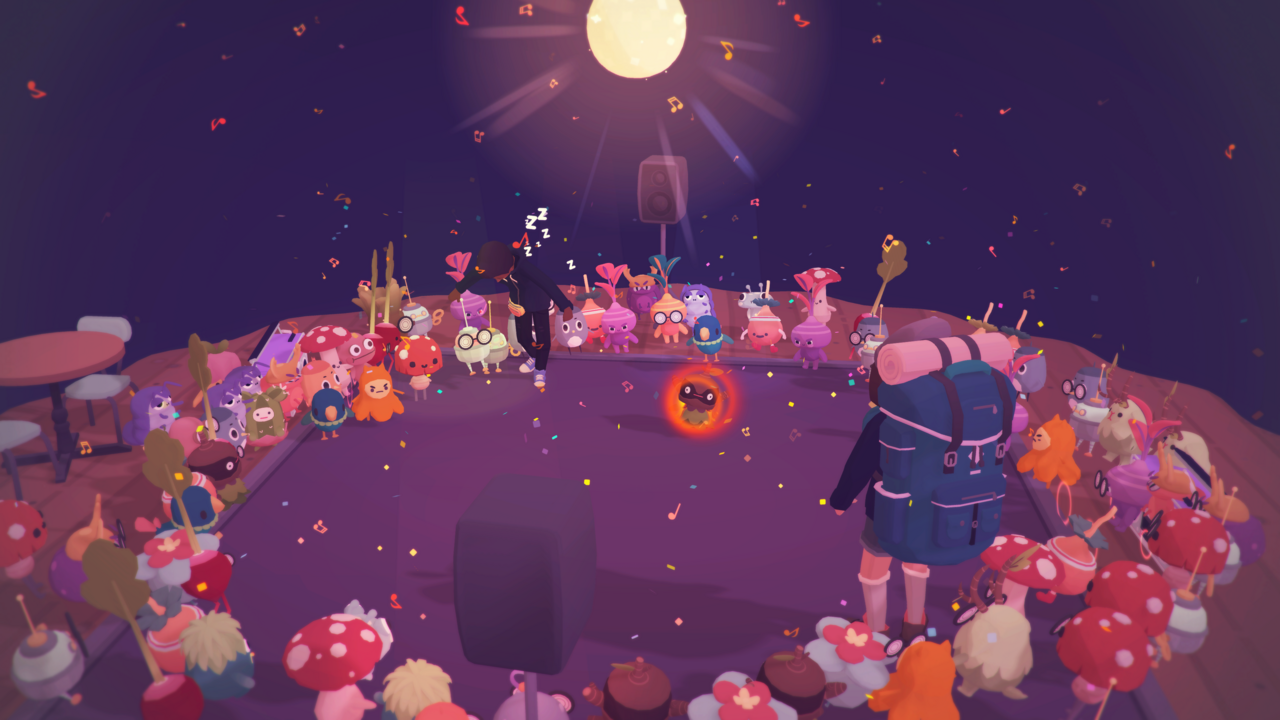Browse your preferred gaming platform's store page for 30 seconds and count the number of guns or knives you see in the various game tiles. Five? 10? Not zero, right? Because much of the games industry has been obsessed with violent conflict for decades now, a counter-culture of alternative games and game developers has emerged more recently to give fans a break from all the bloodlust and brooding anti-heroes. Thanks to a healthy indie scene, games of all sorts and made for all kinds of players are now better able to come to fruition. Not everyone cares to play yet another first-person shooter set to the backdrop of a futuristic war, 1960s Vietnam, or an alien invasion, which tends to be what the AAA space focuses on, and so-called wholesome or non-violent games have drawn in huge fanbases as a result.
For people seeking an often quainter virtual experience, these wholesome games--which today have gone from genre descriptor to full-on brand--are a welcome alternative. However, given the movement's intent to wash its hands of the messy glorification of violence so many mainstream games depict, its consistently poor depiction of nonhuman animals leaves so much to be desired. I believe this problem stems from a larger societal view toward animals that too often disregards their well-being even when it's not a zero-sum game with our own. If creators, promoters, or players really want to shed themselves of the violence the industry is fueled by, they ought not forget about the casual violence still depicted in even the otherwise most cheerful stories and settings.
Perhaps the poster child for the wholesome games genre, Animal Crossing, is both inspired by predecessors like Harvest Moon and a direct inspiration for games that have followed it, such as Disney Dreamlight Valley. Its gameplay loop consists of breezy activities such as decorating your house, designing clothes, and gardening. It's certainly one of the most successful games of its kind in the industry's history. I would never argue its success, but I do take issue with its label as a wholesome or non-violent game. In Animal Crossing, one of the major daily activities is fishing. Both here and in many other examples within the genre, it's the fishing mechanic that most reliably reveals the dissonance between what a game's vibe is intended to be and what it actually depicts.
Fish don't enjoy being tricked into biting a hook. When it happens to them, it doesn't just take away their autonomy, it inflicts pain on them. For a long time, people argued whether or not fish even felt pain, since they don't seem to express it in the anthropocentric ways humans often prefer other species communicate with. Recent studies confirm, however, that fish feel pain.

You may be thinking, "So what? These are video game fish. They aren't real." I agree. These obviously aren't real fish whose feelings we may want to worry about. But what matters is how we are often comfortable depicting casual violence such as sport fishing in a game that is universally praised as non-violent and wholesome. Just as we expect our media to offer thoughtful depictions of mental health, gender issues, or, yes, even the catch-all "politics," it's reasonable to expect thoughtful depictions of nonhuman animals, especially when they wind up in our video games so often.
As a thought experiment, imagine Animal Crossing involves a game where you hook not fish with worm bait, plucking them from their waters, but instead you're required to catch cats--with hooks and all--by coercing them into a trap like fish. Could you imagine such a game earning a spotlight in next year's Wholesome Direct? I think the obvious answer is no. But games with fishing mechanics are one of the most prevalent types showcased every time the brand takes the virtual stage. They both feel pain, so why does harm to fish still pass as wholesome?
It goes beyond fishing, too. Games labeled as wholesome will routinely depict things such as factory-farmed foods, leather goods, and animals in captivity. The creators of the Wholesome Games brand have previously defended the term by calling it "subjective," adding that it can "shift based on context." This is certainly true. It's not really violence itself that the brand dodges, it's the glorification of violence and the depiction of the mighty or many exploiting the weak or few.
Night in the Woods is, I'd argue, a wholesome game, and it depicts a severed arm and a character being shot with an arrow. But it does this within a sensible context--a disenfranchised character's quarter-life crisis in a rundown town with a dying economy. If a game can successfully "punch up," it may very well be wholesome still in the eyes of a wholesome gamer--and mine, too, I'll add. But surely subjectivity doesn't permit everything, or else what good is the label?
You won't find the game with cats and hooks at a Wholesome-branded event ever, just like you won't see a game that glorifies bullying children, tormenting the sick, or antagonizing the unhoused. There are plenty of depictions that are blatantly never going to appear on the Wholesome virtual stage. So why does certain animal violence and exploitation get a free pass?
The answer is deeper than the curation decisions of a few brand managers. I don't blame the Wholesome Games showrunners for the disconnect. This is less about Wholesome Games as a brand and more about the idea of what makes a game wholesome. Though I feel the brand could do more to help shed this perception with its sizable platform, it didn't invent the cognitive dissonance that allows people to both believe a game is certifiably non-violent in its content and have the knowledge that fishing, leather, and milk don't happen without animal suffering. Humans have been comfortable believing two contradictory things at once for a long time.
Picture the common milk carton with cartoon images of happy cows. Now compare that to the reality of a dairy cow, whose baby is stolen from her shortly after birth so the farmers can hoard the milk in a factory where the conditions are so dirty, miserable, and bloody that agriculture lobbies successfully pushed to make it illegal to film or photograph them. The reality is, if we weren't shielded from the inhumane conditions we put animals through by the billions, daily, many of us would be swayed to stop participating in the process. That's bad for business, so dairy farmers and meat packers tuck it away from society. Advocating for better animal welfare is a battle of perception versus reality, and by routinely depicting animals as unharmed and cheerful in captivity, so-called wholesome games once meant to distance themselves from violence and exploitation further fall into the trap that humans often do elsewhere in their lives. They leave conscious creatures behind.
You may also think, "So what? As you said, most games are about violence anyway." That's certainly true of AAA games, which is why I don't hold Red Dead Redemption or Assassin's Creed to the same standard I do Ooblets or Bear and Breakfast. There was an uproar of criticism when Far Cry 6 launched with its cockfighting mini-game. The totally avoidable side attraction was a waste of time, allowing players to fight 2D battles between super-chickens with a Tekken-like overlay. It was one big joke and the lowest-hanging of all fruit.
Many people expressed frustration, or worse, at Ubisoft's brazen choice--ironic given how many of them may have eaten eggs that morning. I neither expected nor sought a thoughtful depiction of animals in Far Cry 6, because it was obvious the game wouldn't have one. This is a series where you upgrade your wallet's carrying capacity by slaying boars and pocketing their bloody entrails in a first-person view. There's no message behind it. It's gotten through the last decade with such objectification in sequel after sequel, so there was no reason to think Far Cry 6 would be different from all the others.

We ought not hold Far Cry to such a standard when it's already a game about bazooka-ing red-clad tyrants and tigers indiscriminately 20 times an hour. I'd no sooner look for a nuanced animal rights message in Far Cry than I would seek out a gun-crafting mechanic in Unpacking. But I would expect a game striving to promote cozy feelings of inclusivity to look beyond just the human characters, and I believe the sooner we move toward including animals in our concerns, be they in reality or in media depictions, the better off everyone will be.
It's an expectation that can be met, too, as already proven by one of the genre's more recent efforts. Ooblets, created by the two-person team at Glumberland, thoughtfully swaps out fishing for "sea-dangling" where the mechanics remain the same but players instead retrieve crafting objects such as wood planks. Rather than make the titular creatures fight each other, like Pokemon, ooblets perform elaborate dance battles. The game even goes so far as to not depict any foods that could be confused as having come from animals--including ooblets, of course. Ooblets includes these changes and loses nothing important in exchange. It's still a terrific game--I'd argue the best of its kind partly because of such thoughtfulness.
No game comes with the directive of depicting animals in a fair light. No game dev owes anyone that by default. One can make a game about a billion different ideas, and there's no minimum number of well-living animals that must appear in any single one of them. But once you've applied the labels of "wholesome" or "non-violent" to a game, it becomes your responsibility to identify and challenge the problematic notions that might be lurking in the gap between what you know and what you show.

